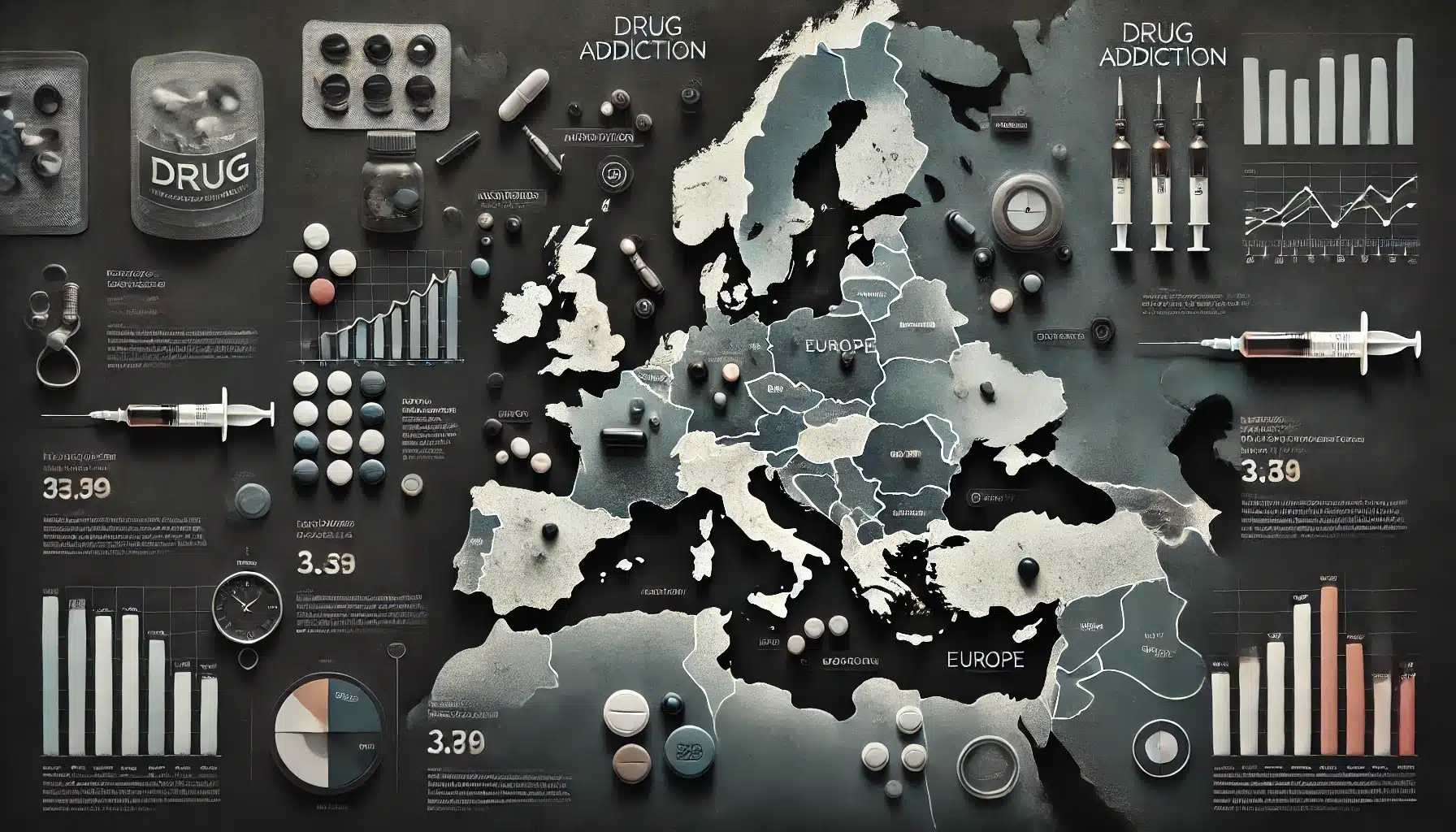addiction
Worse Than Fentanyl? New Opioid Isotonitazene Deepens Opioid Issue
Published
2 years agoon
By
admin
Isn’t it enough that fentanyl exists? We’ve got people dropping like flies in the US and beyond, with a lot of these deaths attributable to the extremely powerful opioid. Now it looks like an even more potent opioid, isotonitazene, might make the already awful opioid situation, even worse.
What is isotonitazene?
Isotonitazene – aka Iso – is an opioid drug, derived from benzimidazole, an aromatic organic compound. It’s in the nitrobenzimidazoles chemical classing of opioids, which makes it structurally different than other opioids like fentanyl. This drug is thought to be more potent than fentanyl slightly, and about 2.5X the strength of hydromorphone – often more recognizable under its trade name Dilaudid.
Its said that isotonitazene is 20-100 times more powerful than fentanyl, which is about 100X stronger than morphine (which goes in line with isotonitazene being 500X morphine). One truth is, as very little research exists on the compound, the specifics are unclear. Another truth is, it was not isotonitazene that was originally taken off the street in 2019, but a structural analogue called etonitazene, which has shown to provide 1000X the analgesia level in mice than morphine, but only about 60X the potency level in humans.
Isotonitazene is said to have half the potency of etonitazene, and is expected to have that same discrepancy between animals and people. If the original studies were done on animals, then the 500-1000X stronger than morphine might simply relate to animal studies. Most medical sources say it’s only slightly stronger than fentanyl.
Thank you for being a part of this. Head to the Cannadelics Weekly Newsletter which provides email updates; along with premium offers on cannabis buds, vapes and equipment, edibles, smoking devices, cannabinoid compounds, and plenty more. We should all get stoned responsibly!
Isotonitazene, as an opioid, has similar characteristics to fentanyl and other opioids, in that it relieves pain, as well as providing the same side effects of nausea, itchiness, and the possibility of overdose due to the depression of the respiratory system. On August 20th, 2020, the DEA did something it has so far refused to do with other opioids like fentanyl, and put isotonitazene in Schedule I on the Controlled Substances list.
Why it classified this drug as 100% illegal, and not the ones more currently responsible for the growing number of opioid overdose deaths, is not immediately clear. Though it fits into the opioid class of drugs, its considered a ‘designer drug’ because it’s synthetic; though realistically, all other pharmaceutical opioids (called synthetic opioids) are also therefore technically designer drugs in the same way. So once again, making that designation for this specific compound, and not the others, makes very little sense.
San Francisco responds to isotonitazene
So far, what’s the damage with isotonitazene? A report earlier this month out of San Francisco expressed the thought that this new opioid on the streets of the California city, could greatly exacerbate the current opioid situation. Much like fentanyl, its being found as an addition to heroine and other opioid products, as a means to increase potency; and is used to make fake drugs.
There aren’t good overdose statistics specifically related to the drug yet, which is something authorities are keeping an eye on moving forward. As an opioid stronger than fentanyl, which would boast similar addiction rates, the unfortunate expectation is that deaths should increase proportionally to whatever increase in use it undergoes.
For a city like San Francisco, it’s making authorities nervous, as the city had in the neighborhood of 620 overdose deaths last year, with 72% of them attributed to fentanyl (and, I imagine, other synthetic opioids). This, of course, is representative of the overall growing fatalities related to these drugs in many places.
Said Matt Dorsey, District 6 Supervisor, “I just want to make sure that our city is set up to monitor it and to be testing for it.” He sent a letter to the medical examiner in regards to this, saying, “I just want to make sure that the Office of the Chief Medical Examiner has everything it needs to test for every potential drug that’s costing the lives of anyone in San Francisco.”
Where else is Isotonitazene causing problems?
Opioids might be known most for their damage in America, but the reality is that heroin and synthetic opioids cause problems in many countries, and isotonitazene is now a part of this. Though the article about San Francisco came out in February 2023, Isotonitazene has been causing problems elsewhere in the world already.
One of the interesting things about Isotonitazene is that while it was seen in several cases from 2019 – through 2020, it was replaced by other similar opioids upon the US putting the drug in Schedule I. Perhaps this is an indication that if the US wants to get rid of fentanyl, illegalizing it might help. Not to ignore that isotonitazene incidences were replaced by another similar drug metonitazene; but the situation does indicate that putting the effort into a formal illegalization, could help if there are support services to keep patients from picking up another opioid instead.
A 2021 study called Emerging characteristics of isotonitazene-involved overdose deaths: a case-control study investigated isotonitazene deaths from January 1, 2020 – July 31, 2020, in two locations: Cook County, Illinois and Milwaukee County, Wisconsin. It compared it to other synthetic opioids. In these counties, there were 40 overdose deaths from isotonitazene, and 981 from other synthetic opioids. The study noted that isotonitazene deaths usually occurred with other medications, more frequently than the other synthetic opioids; with particularly large concurrent use of the benzodiazepine flualprazolam.

Another report from UNODC in 2020 said that isotonitazene was only responsible for eight deaths in the US between June 2019 and December 2019. Either these numbers are lower than reality, the ones above are higher than reality, or the drug gained popularity greatly between 2019 and 2020.
The UK is another location where a little data does exist on deaths. According to the Advisory Council on the Misuse of Drugs, Isotonitazene was related to 24 deaths in 2021. In comparison, 2021 saw 2,219 opioid deaths in the UK (about 45% of all overdoses for the year).
A case report out of Switzerland in 2021 identified three different cases of deaths due to Isotonitazene, though in each case it was used with other drugs. In two cases this involved benzodiazepines among other drugs, and one included alcohol.
Right now, the stated cases are the only ones to give death statistics for the drug. Though it seemed to have its glory period between 2019 and 2021, the recent incidence of it in San Francisco signals that it either is coming back, or the article was more a hype piece about a drug that really isn’t seen often. Given the popularity of opioids, and the desire to get more and powerful versions, its not strange to think its making a reappearance.
The opioid epidemic
Opioids have become one of the bigger health concerns, with the largest issues still in the US, though countries like the UK and Canada certainly have their own issues. The choice by British Columbia in Canada to decriminalize all drugs is in direct relation to the growing opioid issue.
Even so, the US is where the meat of the problem is found. From 2019 to 2020 to 2021, overdose rates went from 73,000 to 93,000 to 107,622. And how many of these deaths did opioids account for? While we were never given an estimate for 2021 that I can find, its expected that over 68,000 of the 93,000 from 2020 were opioid-related, and over 48,000 of the 73,000 from 2019 were as well. Following the trajectory, it could be that close to 100,000 deaths in 2021 were from opioids.
It will be time before we have 2022 numbers, but nothing indicates a decrease, and everything indicates an increase. What did come out earlier this year, is New York City data from 2021 on opioid overdoses. 668 lost their lives that year to drug overdoses, and it was established that just fentanyl (minus other synthetic opioids) was responsible for 80% of these. Overdose numbers for 2021 were 78% higher than in 2019. This makes it the most common drug to show up in overdose scenarios, for five years straight.
The problem is so bad, and is so squarely put on the pharmaceutical companies involved, that in February 2022, Johnson & Johnson, AmerisourceBergen, Cardinal Health, and McKesson, offered Native American communities $590 to settle lawsuits against them for their drugs destroying so many communities. On a global level, the payout number was settled at $26 billion for the same companies.

And while they give the ridiculous line that these payouts don’t constitute guilt: Johnson & Johnson quote: “This settlement is not an admission of any liability or wrongdoing and the company will continue to defend against any litigation that the final agreement does not resolve,” the day I see a pharmaceutical company choose of their own volition to give up that much of their profits… well, you see where I’m going with this.
Those lawsuits aren’t even the end of it. That announcement about the $26 billion, came before another settlement with the entire state of Idaho. In this one, the same companies are paying yet another $119 million. And that’s just Idaho, imagine if the rest of the US states did the same. Maybe some are now.
It doesn’t even stop there. For their part in it, the pharmacy companies CVS, Walgreens, and Walmart were up against more than 300 lawsuits for their participation in the opioid game. And as of November 2022, they’re set to pay out $13 billion.
Perhaps the grossest issue of all? The US government, and any government that allows the drugs through regulation; is not only saying this is all okay (despite whatever lines they use to sound otherwise), they’re promoting the problem further. Hell, last year, it came up to lower guidelines for opioid prescriptions. I mean, is there a better way to say the government is complicit? And all this while ketamine has repeatedly shown comparable abilities for pain control, long lasting effects well beyond treatment, and no addiction or real overdose potential.
Conclusion
Do we have to worry about isotonitazene? With the current opioid issue, you better believe it. The one comforting fact, perhaps, is that at least with this one, the US government was smart enough to actually make it completely illegal.
Welcome to the site! Thanks for making it to Cannadelics.com; a news site in the cannabis and psychedelics spaces, bringing you the best stories of today. Pop around frequently to keep in-the-know on related topics, and subscribe to our Cannadelics Weekly Newsletter, to ensure you’re never late to get the news.
Related
You may like
addiction
Can Psychedelics Treat Addiction and Alcoholism?
Published
7 months agoon
September 13, 2024By
admin
Psychedelics, once associated primarily with counterculture and recreational drug use, are now being seriously studied for their therapeutic potential in treating drug addiction and alcoholism. Recent research has shown that substances like psilocybin, LSD, and ayahuasca may have profound benefits for individuals struggling with Alcohol Use Disorder (AUD) and substance use disorders (SUD). These compounds are being reconsidered not only for their ability to induce altered states of consciousness but also for their potential to address addictive behaviors and psychological trauma at the root of addiction.
Psilocybin’s Efficacy in Treating Alcohol Use Disorder
One groundbreaking study, conducted at New York University and Johns Hopkins University, demonstrated the potential of psilocybin in treating Alcohol Use Disorder (AUD). The researchers focused on individuals with severe AUD, administering two doses of psilocybin in conjunction with psychotherapy. The results were notable: participants reported a 50% reduction in heavy drinking days over an eight-month period, with some maintaining abstinence from alcohol even a year later.
The trial followed a double-blind, randomized approach and found that the therapeutic effects of psilocybin were superior to those observed with placebo treatments. Dr. Michael Bogenschutz, a lead researcher in the study, emphasized the importance of the psychedelic experience itself in breaking the cycle of addiction. Psilocybin appears to help patients break through entrenched mental patterns, often revealing deeper emotional connections and realizations that drive more meaningful behavior change.
How Psychedelics Influence the Brain to Combat Addiction
The mechanism behind the efficacy of psychedelics in treating addiction is thought to involve neuroplasticity, or the brain’s ability to reorganize and form new connections. By interacting with serotonin 2A receptors, particularly in the prefrontal cortex and default mode network, psychedelics can enable profound shifts in perception and cognition. These altered states of consciousness allow individuals to confront underlying psychological issues, such as trauma or negative emotional patterns, which are often at the core of addictive behaviors.
Many individuals undergoing psychedelic-assisted therapy report experiencing a “reset” of their mental state, facilitating a more open mindset that helps them engage with therapy in a deeper, more effective way. This contrasts with traditional addiction treatments, such as methadone or buprenorphine, which primarily manage withdrawal symptoms but do not address the psychological components of addiction.
LSD and Its Potential in Addiction Treatment
LSD (lysergic acid diethylamide) has also shown promise in treating addiction, particularly alcoholism. Early studies from the 1950s to the 1970s suggested that LSD might help reduce alcohol dependency, but interest in this line of research waned due to regulatory crackdowns on psychedelic research. However, more recent studies have reignited interest in LSD’s therapeutic potential.
A meta-analysis published in the Journal of Psychopharmacology reviewed data from six trials involving over 500 patients. It concluded that a single high dose of LSD, administered in a therapeutic setting, was associated with a significant reduction in alcohol consumption. The study found that LSD’s psychedelic effects could lead to lasting changes in personality traits, such as openness and emotional resilience, which are crucial for overcoming addiction.
Ayahuasca and Addiction Recovery
Ayahuasca, a traditional Amazonian brew containing DMT (dimethyltryptamine) and MAO inhibitors, has been the focus of recent studies examining its potential to treat addiction. Researchers have found that ayahuasca’s intense psychoactive properties, combined with its ability to facilitate introspection and emotional healing, may help individuals overcome opioid and stimulant addiction. A study published in Frontiers in Pharmacology noted that ayahuasca led to significant improvements in mental health and reductions in addictive behaviors.
Ayahuasca ceremonies, often conducted in a spiritual context, have been shown to promote healing through vivid and sometimes challenging visions. Participants often report gaining insights into the underlying causes of their addiction, leading to long-lasting psychological benefits.
Challenges in Psychedelic-Assisted Therapy
While the results of these studies are promising, the use of psychedelics in treating addiction is not without challenges. For one, the psychedelic experience itself can be unpredictable, and not all patients experience the profound mystical or emotional breakthroughs associated with positive outcomes. The effectiveness of psychedelic-assisted therapy appears to be linked to the quality of the therapeutic environment and the expertise of the facilitators, meaning that careful preparation and integration are key to success.
Moreover, while psychedelics like psilocybin and LSD do not appear to be physically addictive, their use must still be carefully regulated to prevent potential psychological risks, such as hallucinations, anxiety, or psychotic episodes in vulnerable individuals. Current research emphasizes the need for controlled settings where trained therapists can guide patients through their psychedelic experiences.
Ongoing Research and Future Directions
Given the promising early results, psychedelic research is entering a new phase, with larger clinical trials currently underway. The National Institutes of Health (NIH) recently allocated $2.4 million to explore the use of psychedelics in treating methamphetamine addiction, further solidifying the role of psychedelics in addiction therapy. Similarly, ongoing studies are looking into psilocybin’s potential to treat opioid addiction and cocaine dependence, conditions that have been notoriously difficult to treat with conventional methods.
As research progresses, it is likely that psilocybin, LSD, and other psychedelics will become more widely recognized as effective tools for addiction treatment. While more research is needed to fine-tune these therapies and better understand their long-term effects, early indications are that psychedelics could revolutionize addiction and alcoholism treatments in the coming decades.
Conclusion
Psychedelics like psilocybin, LSD, and ayahuasca are emerging as potential breakthrough therapies for treating drug addiction and alcoholism. By promoting neuroplasticity and addressing the psychological roots of addiction, these substances offer an alternative to traditional addiction treatments, which often focus on managing symptoms rather than curing the disease. With ongoing research and increasing clinical trials, psychedelic-assisted therapy may become an essential tool in the fight against substance use disorders, offering hope to millions of people who struggle with addiction, such as alcoholism.
Sources
Johns Hopkins Medicine: Psychedelics in Addiction Treatment
Progress in Neuro-Psychopharmacology and Biological Psychiatry
National Institutes of Health (NIH) Research on Psychedelics
Frontiers in Pharmacology: Ayahuasca for Addiction Recovery
JAMA Otolaryngology – Head & Neck Surgery
Related
addiction
The Evolving Opioid Crisis in Europe: Heroin and Synthetic Threats
Published
7 months agoon
September 12, 2024By
admin
The opioid crisis in Europe is growing in complexity, with heroin continuing to dominate the market while synthetic opioids, such as fentanyl and its analogs, emerge as potent new threats. The 2024 EU Drug Markets Report, released by the European Monitoring Centre for Drugs and Drug Addiction (EMCDDA) and Europol, provides a comprehensive analysis of the heroin and synthetic opioid market, detailing the health risks, evolving trafficking routes, and potential future challenges.
Heroin in Decline? Why Synthetic Opioids Pose a New Threat in Europe
Heroin’s Ongoing Impact in Europe
Heroin remains the most commonly used illicit opioid in Europe, with an estimated 1 million high-risk opioid users. The European heroin market is valued at over €5.2 billion annually, indicating the persistent demand for this drug. In 2021, EU countries seized 9.5 tonnes of heroin, the largest quantity in 20 years. These figures underscore the strong presence of heroin in Europe, despite the introduction of harm reduction programs aimed at curbing opioid use.
The health consequences of heroin use are severe. In 2021, opioids were responsible for three-quarters of Europe’s 6,000 drug-related overdose deaths, with heroin being a leading factor. Long-term users are aging, adding complexity to public health strategies, as older opioid users present with more chronic health problems.
Afghanistan’s Opium Ban: Future Implications for Heroin Supply
Nearly all heroin consumed in Europe is derived from opium produced in Afghanistan. However, Afghanistan’s opium production has seen a dramatic decline following the Taliban’s 2022 ban on poppy cultivation, which led to a 95% reduction in production by 2023. While the immediate impact on heroin availability in Europe has been minimal, the report warns that a sustained ban could lead to future heroin shortages. Such shortages could open the door for synthetic opioids to dominate the market.
The decline in Afghan opium cultivation from 233,000 hectares in 2022 to just 10,800 hectares in 2023 has raised concerns about the future of heroin availability in Europe. Should the Taliban continue to enforce the ban, experts believe the resulting heroin scarcity could increase the use of more potent and dangerous synthetic opioids, exacerbating the public health crisis.
The Rise of Synthetic Opioids: Fentanyl and its Analogues
Synthetic opioids, such as fentanyl, are becoming more prevalent in the European drug market. These substances are far more potent than heroin, and even small doses can lead to fatal overdoses. The 2024 report highlights how these synthetic opioids are contributing to a growing number of overdose deaths and hospital emergencies across Europe. In countries such as Estonia and Sweden, fentanyl is responsible for a significant proportion of drug-related deaths.
Fentanyl analogs are particularly concerning because they can be mixed with other drugs like heroin or cocaine, often without the user’s knowledge. The increasing presence of these synthetic opioids is a major public health concern, as traditional harm reduction measures, such as naloxone distribution and needle exchange programs, are less effective against these more potent substances.
Changing Trafficking Routes and Criminal Networks
Traffickers are increasingly adapting their methods in response to heightened enforcement measures and geopolitical developments. The traditional Balkan route, which brings heroin through Turkey and Bulgaria into Europe, has seen increased enforcement and stricter border controls, prompting traffickers to shift towards alternative routes.
The Southern route is becoming more prominent, with significant heroin shipments passing through Iran and Pakistan before reaching Europe via major seaports. The United Arab Emirates (UAE) has emerged as a key transshipment hub for heroin, providing both logistical support and avenues for money laundering. Meanwhile, the ongoing Russia-Ukraine war has prompted criminal networks to modify their trafficking routes, further complicating law enforcement efforts.
Public Health and Harm Reduction Efforts
Harm reduction strategies have had some success in mitigating the impact of opioid use in Europe. Programs such as opioid substitution therapy (OST) and needle exchange have helped reduce the number of new users injecting heroin, thereby lowering the risks of HIV and hepatitis C transmission. However, the growing prevalence of synthetic opioids poses new challenges. These potent drugs often require stronger overdose prevention measures, such as fentanyl test strips and more widespread access to naloxone, an opioid antagonist used to reverse overdoses.
Additionally, the report notes the importance of expanding data collection and improving early warning systems to monitor emerging trends in opioid use and trafficking. These systems allow public health authorities and law enforcement to respond more quickly to new synthetic opioids entering the market.
Challenges in Treating Opioid Addiction
Treatment for opioid addiction, particularly heroin, is evolving. Europe’s aging population of opioid users presents new challenges, as older users are more likely to have complex medical conditions. Many long-term users require not just drug treatment but also social support and healthcare for chronic conditions related to long-term substance use. Furthermore, gender-specific issues are emerging, as women who use opioids face more barriers to accessing treatment and are more likely to present with co-occurring psychological or social issues.
Conclusion
The opioid crisis in Europe is evolving, with heroin still posing a significant threat to public health, while synthetic opioids like fentanyl are emerging as an even more dangerous force. The reduction in Afghan opium production and the shifting trafficking routes complicate the landscape further. To tackle this complex issue, Europe must continue to invest in harm reduction, international cooperation, and early warning systems to prevent more overdose deaths and manage the changing face of the opioid market. Without a coordinated response, Europe risks facing an even more devastating public health crisis in the coming years.
Related

The fact that some people are eating dogs and cats is a highly sensitive topic that crosses cultural, social, and ethical boundaries. In many regions, these animals are consumed due to cultural traditions and necessity, while in other cases, drug-induced behavior may lead individuals to engage in extreme or unusual dietary practices. This article aims to explore the distinction between cultural norms and the desperate, erratic behaviors driven by substance abuse, focusing on the need for cultural sensitivity while addressing harmful behavior.
When Culture Meets Addiction: Who Is Eating Dogs and Cats?
Cultural Practices and the Consumption of Non-Traditional Animals
In some parts of Asia and Africa, the phenomena of eating dogs and cats has historical roots that are tied to both cultural traditions and the availability of resources. In these regions, the eating of non-traditional animals is a normalized practice and is not connected to drug-fueled behavior.
- Cultural Normalcy: In regions such as South Korea, China, and Vietnam, dogs have historically been consumed as part of traditional cuisines. This practice is not driven by addiction or desperation but by cultural norms that view these animals as a food source rather than pets.
- Food Scarcity: In some communities, especially in impoverished or rural areas, consuming non-traditional animals like dogs or cats is a practical response to food scarcity. The decision to eat these animals is based on survival rather than personal preference or altered judgment.
Drug-Induced Dietary Choices: When Addiction Leads to Extreme Behaviors
In contrast to cultural practices, there are cases where individuals under the influence of drugs engage in extreme or bizarre behaviors, such as eating dogs and cats… This behavior is driven by impaired judgment, psychosis, or desperation caused by addiction, and often occurs in isolated or marginalized communities.
- Methamphetamine and Erratic Behavior: Meth users are known to exhibit extreme and irrational behaviors, including eating animals they wouldn’t normally consider food. Meth-induced psychosis can blur the lines between reality and hallucination, leading to bizarre dietary choices such as consuming pets or strays.
- Desperation from Heroin Addiction: Heroin addicts, especially those living in extreme poverty, may consume non-traditional animals out of necessity. Chronic malnutrition and impaired judgment, combined with isolation from society, can drive addicts to make choices they wouldn’t otherwise consider.
Understanding the Cultural vs. Drug-Fueled Divide
It’s crucial to differentiate between cultural practices and behaviors driven by addiction when discussing the consumption of non-traditional animals. Respecting cultural practices while addressing the harmful impacts of substance abuse requires a nuanced understanding of these different contexts.
- Cultural Sensitivity: When discussing the consumption of non-traditional animals, especially in regions where this practice is accepted, it is important to approach the subject with cultural sensitivity. Condemning these practices without understanding their historical and social context can perpetuate stereotypes and breed intolerance.
- Addressing Addiction-Related Behaviors: Conversely, when the consumption of animals like dogs and cats is tied to addiction, the focus should be on treating the root causes of drug abuse rather than criminalizing individuals. Rehabilitation, mental health support, and access to food resources are critical in preventing desperate behaviors.
Ethical Considerations and Animal Welfare
Regardless of whether the consumption of non-traditional animals is driven by culture or desperation, the ethical treatment of animals is a key concern. The dog and cat meat industries have come under scrutiny for their inhumane treatment of animals, and organizations worldwide are working to promote animal welfare and ethical eating practices.
- Animal Rights in Cultural Contexts: While respecting cultural traditions, animal rights organizations are increasingly advocating for more humane practices within these industries. Campaigns to ban or reduce the consumption of dog and cat meat have gained traction, with a focus on reducing cruelty and promoting alternative food sources.
- Animal Cruelty and Drug Addiction: In cases of drug-induced behaviors, the animals involved often suffer from neglect or harm. Providing support for addicts and ensuring animals are removed from harmful environments can help mitigate this issue.

How to Approach the Issue Globally
Addressing the issue of non-traditional animal consumption, whether cultural or drug-fueled, requires a global approach that balances respect for cultural practices with the promotion of humane treatment for animals. Public health initiatives and cultural sensitivity training can help bridge the gap between different viewpoints while ensuring that animals and people alike are treated with dignity.
- Promoting Cultural Understanding: Efforts to educate the public on the cultural contexts of eating non-traditional animals can help reduce prejudice and promote more respectful global dialogues. Cultural exchange programs and educational campaigns can provide a more nuanced view of these practices.
- Addressing Substance Abuse: On the other hand, combatting the desperation and irrational behavior caused by addiction requires investments in mental health, addiction treatment, and public welfare systems. Providing addicts with support, housing, and access to food can reduce the likelihood of harmful or extreme behaviors.
Conclusion
While the consumption of non-traditional animals like dogs and cats may be culturally accepted in some regions, drug-induced behaviors that lead to similar actions must be understood in a different light. It’s important to address addiction-related behavior with compassion, focusing on rehabilitation and support rather than punishment. At the same time, promoting animal welfare and humane practices in regions where these animals are consumed can create a more ethical global community. By approaching these issues with respect for cultural diversity and a commitment to reducing harm, both animals and humans can benefit.
Related

This Wine Issue Is Becoming More Common

Get more for less this 420 at PurLife

Can You Order Cannabis through DoorDash?

Cannabis Enthusiast-Friendy Retreats – GanjaVacations Jamaica

The road ahead for cannabis lending in 2025

Cannara Biotech Announces Appointment of Justin Cohen to Board of Directors

Can Marijuana Help Cholesterol – The Fresh Toast

Safe Cannabis Consumption During Wildfire Season

Food Asphyxiation Is Way More Dangerous Than Cannabis

Outdoor Marijuana Grows Are Better All The Way Around

Distressed Cannabis Business Takeaways – Canna Law Blog™

United States: Alex Malyshev And Melinda Fellner Discuss The Intersection Of Tax And Cannabis In New Video Series – Part VI: Licensing (Video)

What you Need to Know

Drug Testing for Marijuana – The Joint Blog

NCIA Write About Their Equity Scholarship Program

It has been a wild news week – here’s how CBD and weed can help you relax

Cannabis, alcohol firm SNDL loses CA$372.4 million in 2022

A new April 20 cannabis contest includes a $40,000 purse

Your Go-To Source for Cannabis Logos and Designs

UArizona launches online cannabis compliance online course
Trending
-

 Cannabis News2 years ago
Cannabis News2 years agoDistressed Cannabis Business Takeaways – Canna Law Blog™
-

 One-Hit Wonders2 years ago
One-Hit Wonders2 years agoUnited States: Alex Malyshev And Melinda Fellner Discuss The Intersection Of Tax And Cannabis In New Video Series – Part VI: Licensing (Video)
-

 Cannabis 1012 years ago
Cannabis 1012 years agoWhat you Need to Know
-

 drug testing1 year ago
drug testing1 year agoDrug Testing for Marijuana – The Joint Blog
-

 Education2 years ago
Education2 years agoNCIA Write About Their Equity Scholarship Program
-

 Cannabis2 years ago
Cannabis2 years agoIt has been a wild news week – here’s how CBD and weed can help you relax
-

 Marijuana Business Daily2 years ago
Marijuana Business Daily2 years agoCannabis, alcohol firm SNDL loses CA$372.4 million in 2022
-

 California2 years ago
California2 years agoA new April 20 cannabis contest includes a $40,000 purse



